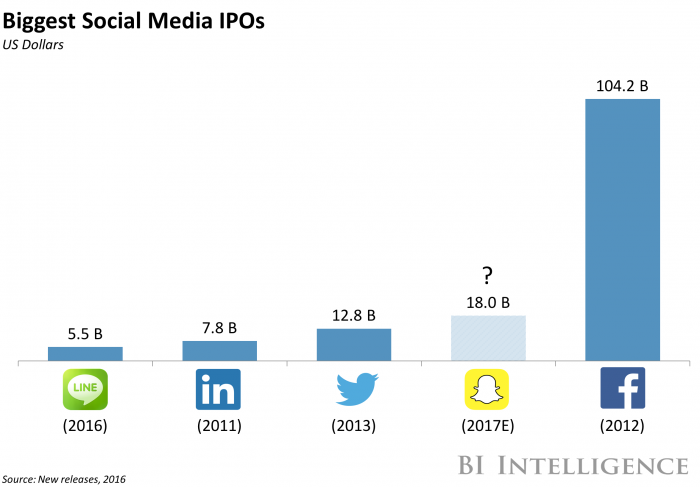Snapchat is opening itself up to more ad targeting

BI Intelligence
This story was delivered to BI Intelligence "Digital Media Briefing" subscribers. To learn more and subscribe, please click here.
Snapchat’s ad targeting abilities have gone up another notch, The Wall Street Journal reports.
A new deal with Oracle Data Cloud (formerly Datalogix) will help match Snapchat users to offline purchasing behavior, allowing marketers to deliver more targeted ads and to better track sales conversions from Snapchat ads.
The deal means Snapchat has finally opened up to ad targeting using third-party data. It’s a first for the social giant, which until now shunned a practice that’s commonplace among its rivals. Google, Facebook, and Twitter have had similar partnerships with Datalogix for a while now, so the Oracle Data Cloud deal will help Snapchat compete against its peers in attracting greater interest from brand advertisers. This will help stoke investor appetite for Snap as the company gears up for an IPO.
Marketers will now be run ads on Snapchat according to 100 different target audiences. These are based on consumer profiles like “cosmetics shopper” or “consumer tech shopper.” However, advertisers won’t be able to target users based on specific products they’ve bought, a Snap representative told Business Insider. This development follows up on the rollout of Snap Audience Match in September, which let marketers use their own lists of email addresses and mobile device IDs to target Snapchat users, and the debut of Snapchat's ads application programming interface (API), which also coincided with a spate of partnerships with over a dozen ad measurement companies.
Relatedly, Snapchat is touting its user engagement to justify a $20 billion IPO valuation. The company has given a heap of engagement metrics to the bankers underwriting its IPO, including numbers on daily active users — which is just above 150 million — the percent of users who take photos in the app, how many of these photos feature geofilters and how many are being saved as Memories, and the percent of users who send messages through the chat feature.
Consumers continue to increase their time spent consuming digital media, while advertisers continue to increase their ad budgets into digital channels.
The influx is not expected to let up in the near future. The US digital advertising industry will continue to experience remarkable growth through 2021 to reach nearly $100 billion in annual revenue, driven primarily by the sustained migration of ad dollars from traditional TV to digital video and the continued increase of social spending.
Overall, the strong growth of the US digital ad market can largely be attributed to increased time spent by consumers on digital media and brands' increased comfort with allocating budgets to digital formats, particularly on digital video. In a recent 2016 survey of almost 400 US ad agencies and marketers, the IAB found that two-thirds of respondents plan on increasing spending on digital video in the next year.
Moreover, mobile will become the top destination for digital ad spending as advertisers continue to attempt to resolve the disconnect between the rapid growth in time spent on phones and tablets and the relatively small share of ad budgets that are allocated to such platforms — known as the mobile opportunity gap. In fact, mobile is set to eclipse desktop ad spend by 2018.
Dylan Mortensen, senior research analyst for BI Intelligence, Business Insider's premium research service, has compiled a detailed report on U.S. digital media ad revenue that forecasts revenue trends over the next five years and outlines the key growth drivers for overall digital ad revenue in the U.S.
Here are some key points from the report:
US digital ad revenue is expected to reach nearly $100 billion by 2021, according to BI Intelligence estimates. This represents compound annual growth of 8% from the $68.9 billion expected in 2016.
Mobile is positioned to become the top destination for digital ad spending as advertisers continue to attempt to close the "mobile opportunity gap."
Digital video advertising will grow faster than any other segment over the next five years, as consumers shift time spent online to phones and tablets. Revenue in this category is forecast to rise from $8.5 billion in 2016 to $23 billion in 2021.
Social advertising in all formats is gaining traction and will be among the key drivers of digital ad growth in the next five years. Social ad revenue is poised to climb to $30.8 billion by 2021, up from $15.5 billion this year.
Artificial intelligence, augmented and virtual reality, and sponsored content will help propel further digital ad growth in the next decade.
In full, the report:
Forecasts US digital ad revenue through 2021.
Highlights the rising popularity of digital media with consumers and brands.
Explores why digital video advertising growth will exceed all other formats over the next five years.
Outlines emerging technologies that will help propel ad growth in the next decade.
To get your copy of this invaluable guide, choose one of the following two options:
Subscribe to an All-Access pass to BI Intelligence and gain immediate access to this report and over 100 other expertly researched reports. As an added bonus, you'll also gain access to all future reports and daily newsletters to ensure you stay ahead of the curve and benefit personally and professionally. » START A MEMBERSHIP
Purchase & download the full report from our research store. » BUY THE REPORT
The choice is yours. But however you decide to acquire this report, you’ve given yourself a powerful advantage in your understanding of digital media ad revenue.
See Also:

 Yahoo News
Yahoo News 

